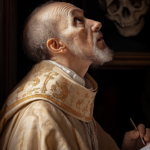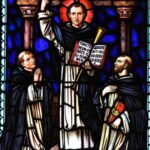St. Edward the Confessor
St. Edward the Confessor
Saint Edward the Confessor: A Timeless Figure of Faith and Kingship
When they lived:
Saint Edward the Confessor, also known as King Edward, lived during the tumultuous and transformative 11th century. He was born on June 1003 in Islip, Oxfordshire, England, and reigned as King of England from 1042 until his death on January 5, 1066.
Where they lived:
Edward the Confessor’s life revolved primarily around England, a land steeped in both history and chaos. The focal point of his reign was the royal palace in Westminster, a site that would later become the iconic Westminster Abbey.
Notable world events during the time of their life:
- The Battle of Hastings (October 14, 1066): This pivotal event marked the Norman Conquest of England and had a profound impact on the nation’s history. William the Conqueror, Duke of Normandy, defeated King Harold II, who died during the battle, effectively changing the course of England’s monarchy and culture.
- The Great Schism (1054): The Christian world was rocked by a major split between the Eastern (Orthodox) and Western (Catholic) branches of the Church. This event, known as the Great Schism, led to lasting religious and political consequences that affected Europe for centuries.
- The Bayeux Tapestry’s Creation (Late 11th Century): A remarkable piece of art and historical record, the Bayeux Tapestry was created around the time of Edward’s reign. This intricate embroidery vividly depicts the events leading up to the Norman Conquest, providing valuable insights into the medieval world.
- The Construction of the Tower of London (Started in 1066): This iconic fortress, originally commissioned by William the Conqueror after his victory at the Battle of Hastings, stands as a symbol of power, intimidation, and British heritage. It remains a must-visit historical site to this day.
- The Investiture Controversy (1075-1122): While this event occurred after Edward’s death, its roots can be traced back to his reign. The Investiture Controversy was a long-lasting dispute between the papacy and secular rulers over the appointment of bishops, which had significant implications for the power balance between Church and State in medieval Europe.
Their Patronage:
Saint Edward the Confessor is venerated as the patron saint of kings, difficult marriages, and separated spouses. He is also regarded as a protector against turmoil and political strife. Edward’s reputation as a pious and just ruler, coupled with his unwavering devotion to his faith, earned him the title “the Confessor” — a term used to designate saints who lived a holy life and died natural deaths rather than suffering martyrdom.
His Appearance
St. Edward is described as being a man of proper figure and outstanding height. He had milky white hair and a beard. He had thin, white hands and long, translucent fingers. He also had an unblemished body, and he was always pleasant and dignified, walking with his eyes cast down. If someone aroused his anger, he seemed as terrible as a lion but never railed, and this is an element of an ideal king.
His Childhood
When St. Edward was younger, England was targeted by Viking raids and invasions under Sweyn Forkbeard and his son Cnut. This resulted in St. Edward’s family fleeing to Normandy. After the death of Sweyn in 1014, Thelred was invited back by the Englishmen on the condition that he promise to rule more justly than before, and he agreed.
St. Edward’s father died in April 1016, and his half-brother Edmund Ironside succeeded him. According to Scandinavian tradition, St. Edmund fought alongside Edmund against Cnut. However, this is disputed since St. Edward was thirteen years old at that time.
Edmund died in November 1016, and Cnut became king, which forced St. Edmund and his sister and brother to go into exile again. In 1017, his mother married Cnut, and in the same year, Cnut had Edward’s last surviving elder half-brother Eadwig executed.
St. Edward spent 25 years in exile, mainly in Normandy, but there is no evidence of his location until the early 1030s. It is assumed that he received support from his sister Godgifu, who was married to Drogo of Mantes. In the early 1030s, St. Edward witnessed four charters in Normandy, signing two of them as the King of England.
According to one Norman chronicler, Robert I, Duke of Normandy, attempted an invasion of England in about 1034 to place Edward on the throne, but it was unsuccessful. St. Edward also had the support of other continental abbots.
Back to the Throne
Cnut died in 1035, and Harthacnut took over in 1041. He invited Edward back to England, probably as an heir, because he knew he had not long to live. St. Edward was sworn in as king in 1042 after the death of Cnut on the condition that he continue Cnut’s laws.
In his early years as King, he restored a strong monarchy, showing himself as a vigorous and ambitious man. The wealth of St. Edward exceeded that of the greatest earls.
St. Edward was King from June 1042 until January 1066. restored the rule of the House of Wessex after a period of Danish rule that had been there since 1016. After St. Edward’s death, he was succeeded by Harold Godwinson, who was defeated and killed in the same year by the Normans under William the Conqueror at the Battle of Hastings.
St. Edward’s great-nephew was proclaimed King after the Battle of Hastings, but he was never crowned. Some historians portray St. Edward the Confessor’s reign as leading to the disintegration of royal power in England and an advance in the power of the House of Godwin. This is because of the infighting that began after his death since he had no heir.
However, others portray St. Edward as a successful king who was full of energy, resourceful, and occasionally ruthless. They attribute the Norman Conquest that happened shortly after his death to tarnishing his image.
St. Edward’s nickname, ‘the confessor,” suggests that he was unworldly and pious. The name confessor reflects that he was a saint who did not suffer martyrdom but rather died peacefully. Edward usually preferred clerks to monks for the most important and richest bishoprics. However, his appointments were generally respectable.
In October 1065, there was an uprising by the rebels as they claimed that he was oppressive, and they killed 200 of his followers. St. Edward was forced to submit to his banishment, and the humiliation is assumed to have been the cause of a series of strokes that led to his death in 1066.
Legacy
He was canonized by Pope Alexander III in 1161, about a century after his death. Now he is recognized as the patron saint of kings, difficult marriages, and separated spouses. His feast day is on October 13th.
5 Interesting Facts About St. Edward the Confessor
- He is usually considered the last king of the House of Wessex.
- St. Edward the confessor is the nephew of St. Edward the martyr.
- In charters, St. Edward was always listed behind his older
half-brothers, showing that he ranked beneath them. - St. Edward was known for accepting bribes.
- St. Edward did not have any children; some reports state that it’s
because he vowed to celibacy, and some reports say that because he
refused to be intimate with his wife due to his hatred of his father.
in law.
Prayer to St. Edward the Confessor
Lord, you raised Saint Edward, king and confessor, to excel in good government and faithful service. May these ideals survive and flourish among us through his prayers. Through our Lord Jesus Christ, your Son, who lives and reigns with you in the unity of the Holy Spirit, one God, forever and ever Amen.



